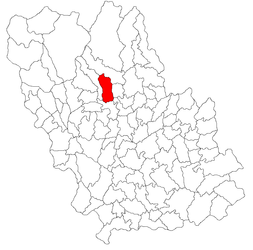Slănic
Slănic | |
|---|---|
 | |
 Coat of arms | |
 Location in Prahova County | |
 Slănic Location in Romania | |
| Coordinates: 45°14′0″N 25°56′21″E / 45.23333°N 25.93917°ECoordinates: 45°14′0″N 25°56′21″E / 45.23333°N 25.93917°E | |
| Country | Romania |
| County | Prahova |
| Government | |
| • Mayor (2020–2024) | Daneluș Costea[1] (PSD) |
| Area | 39.2 km2 (15.1 sq mi) |
| Population (2011)[2] | 6,034 |
| • Density | 150/km2 (400/sq mi) |
| Time zone | EET/EEST (UTC+2/+3) |
| Vehicle reg. | PH |
| Website | www |
Slănic (Romanian pronunciation: [sləˈnik]) is one of the 12 towns of Prahova County, Muntenia, Romania, historically and currently known as a salt extraction center, as well as a spa town, with salt lakes. Two villages, Groșani and Prăjani, are administered by the town.
Etymology[]
| Year | Pop. | ±% |
|---|---|---|
| 1912 | 5,512 | — |
| 1930 | 6,306 | +14.4% |
| 1948 | 6,495 | +3.0% |
| 1956 | 6,842 | +5.3% |
| 1966 | 7,307 | +6.8% |
| 1977 | 7,780 | +6.5% |
| 1992 | 7,654 | −1.6% |
| 2002 | 7,249 | −5.3% |
| 2011 | 5,934 | −18.1% |
| Source: Census data | ||

As its name (salt in Slavonic) suggests, most of Slănic's history and economy are directly related to the presence of relatively large quantities of salt underground, and even in open air.
Slănic is also the name of the creek flowing through the town, tributary of Vărbilău River, which in turn is a tributary of Teleajen River.
Although technically incorrect, the compounded name Slănic Prahova is also being used, especially in other parts of Romania. This alternative name was probably generated to help discern between Slănic and another Romanian town, Slănic-Moldova.
Natives[]
Climate[]
Slănic has a humid continental climate (Cfb in the Köppen climate classification).
| hideClimate data for Slănic | |||||||||||||
|---|---|---|---|---|---|---|---|---|---|---|---|---|---|
| Month | Jan | Feb | Mar | Apr | May | Jun | Jul | Aug | Sep | Oct | Nov | Dec | Year |
| Average high °C (°F) | 1.9 (35.4) |
4 (39) |
8.7 (47.7) |
14.2 (57.6) |
19.1 (66.4) |
22.7 (72.9) |
24.8 (76.6) |
24.9 (76.8) |
19.8 (67.6) |
14 (57) |
8.5 (47.3) |
3.7 (38.7) |
13.9 (56.9) |
| Daily mean °C (°F) | −2.4 (27.7) |
−0.6 (30.9) |
3.7 (38.7) |
9.4 (48.9) |
14.5 (58.1) |
18.3 (64.9) |
20.3 (68.5) |
20.3 (68.5) |
15.3 (59.5) |
9.5 (49.1) |
4.6 (40.3) |
−0.4 (31.3) |
9.4 (48.9) |
| Average low °C (°F) | −6.1 (21.0) |
−4.7 (23.5) |
−1.2 (29.8) |
4.1 (39.4) |
9.2 (48.6) |
13.2 (55.8) |
15.3 (59.5) |
15.3 (59.5) |
10.9 (51.6) |
5.6 (42.1) |
1.3 (34.3) |
−3.7 (25.3) |
4.9 (40.9) |
| Average precipitation mm (inches) | 45 (1.8) |
44 (1.7) |
59 (2.3) |
88 (3.5) |
130 (5.1) |
138 (5.4) |
136 (5.4) |
101 (4.0) |
72 (2.8) |
62 (2.4) |
55 (2.2) |
53 (2.1) |
983 (38.7) |
| Source: https://en.climate-data.org/europe/romania/prahova/slanic-15400/ | |||||||||||||
Tourism[]

The town is famous for its salt lakes (or Băi): The Shepherd’s (), The Green () and The Red () Lakes, as well as for the Old (Salina Veche) and New () Salt Mines. While salt is still being extracted from the New Salt Mine, the Old Mine is open to the public now, being used as a spa, amusement center and museum of the salt mining industry. International contests of Flying () take place annually in the upper level (Mina Mihai) of the Old Mine.
Other worthwhile tourist objectives, all within easy reach for any untrained hiker, are a local water spring named The Cold Fountain (), the TV Relay Tower () beyond The Fir Forest (), Beacon's Hill (), The Salt Mountain () with the legendary Bride's Cave (Grota Miresei), now partially collapsed due to rain erosion, as well as The Green Rock () and The Colt's Small Hill (Delușorul Mânzului).
References[]
- ^ "Results of the 2020 local elections". Central Electoral Bureau. Retrieved 9 June 2021.
- ^ "Populaţia stabilă pe judeţe, municipii, oraşe şi localităti componenete la RPL_2011" (in Romanian). National Institute of Statistics. Retrieved 4 February 2014.
External links[]
| Wikimedia Commons has media related to Slănic. |
- Memoirs de la Mine by Sabina Ispas. (Map of region, pictures, brief history of the town)
- Tourism Slanic Prahova (Great pictures taken underground, in the Old Salt Mine)
- History of Jewish communities worldwide. (Brief description of the town, some historic data)
- Totul despre Slanic (Pictures and some information on town's history/economy/tourism - text in Romanian)
- Romanian Modellism Federation (Results of the 2006 Edition of the World Championship of Indoor Aircraft, Slanic, Romania)
- International Aeronautic Federation (Program of the 2006 Edition of the World Championship of Indoor Aircraft - Slanic, Romania)
- Towns in Romania
- Mining communities in Romania
- Populated places in Prahova County
- Localities in Muntenia
- Spa towns in Romania

